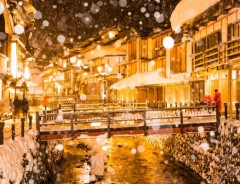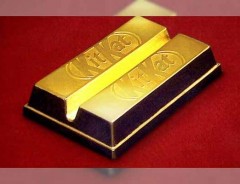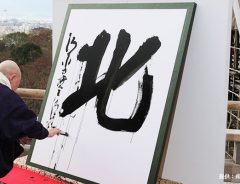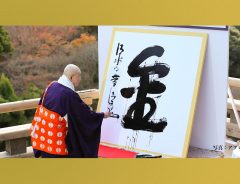- Tags:
- Chūson-ji / Chūson-ji Temple / Gold / Golden Hall / Hiraizumi / Konjikidō
Related Article
-

Play Old School Games On This Crazy Expensive 24k Gold NES
-

Japanese Twitter User Traveling Tohoku Wound Up In A Gold, Snowy Heaven
-

SGC and Nidec Sankyo begin selling golden music boxes just in time for the New Year
-

Gold-Plated Kit Kats (Made With Real Gold!) Are Japan’s Newest Kit Kat Bars
-

Every Year Has A Character: Japan Chooses Its “Kanji of the Year” 2017
-

Monumental feats, new 500 yen coin contribute to choice of “Gold” as 2021’s Kanji of the Year



In the Travels of Marco Polo, the great Venetian explorer calls Japan “the land of gold – Zipangu.” It is believed that he wrote these words while he was in China, after hearing rumours of a land to the east where there was a palace made entirely of gold.
At the time, Marco Polo was only a few years into a 24-year odyssey that would take him the length of the Silk Road, including 17 years in the service of the Chinese emperor, Kublai Khan. He wrote his account of his travels after returning to Venice in 1295, and it quickly became a bestseller.
A statue of Marco Polo in the garden of Villa Borghese in Rome. | Krzysztof Golik, CC BY-SA 4.0, via Wikimedia Commons
Marco Polo’s descriptions of the mysterious culture and inner workings of the Eastern world inspired wonder in the Europeans who read it. Among the wonders he related in his book, also known as the Book of the Marvels of the World, none was more wondrous than ‘Zipangu,’ a fabled land thought to be fabulously rich in silver and gold.
Although Marco Polo never made it as far as Japan, rumours of its wealth were quite true, for its volcanism gave its people access to precious ores like gold without their having to resort to deep-mining technology, which had yet to be invented.
Moreover, the palace made entirely of gold that Marco Polo heard about actually existed – and still exists today. This is Konjikidō 金色堂 – the Golden Hall - in Chūson-ji Temple 中尊寺, Hiraizumi 平泉, a town in Iwate prefecture in northern Japan.
Hiraizumi was once a paradise made rich by gold. For about 100 years from the beginning of the 12th century, the Ōshū Fujiwara 奥州藤原 family governed the region. They panned its rivers for gold dust, which paid for magnificent houses and wonders of religious art to rival Kyoto, the capital of the country at the time.
The founder of the Ōshū Fujiwara family, Fujiwara no Kiyohira 藤原清衡, put Buddhism at the heart of his administration. The Buddhist pure land was believed to be a celestial realm of peace where people lived in equality. What made Fujiwara no Kiyohira different was that, rather than wait to go to a distant paradise after he died, he wanted to create an ideal city on earth. He wanted his people to be rich, but he also wanted them to live in peace and equality.
He built Chūson-ji Temple, the main temple of the Tendai sect in the Tohoku region, as an emblem of his wish. It was the most glorious of a series of architectural treasures he had built in Hiraizumi. When he died, his son succeeded him, and the city flourished for another hundred years.
But the wondrous city came to a cataclysmic end. The twelfth century was a time of terrible rivalry between the Minamoto and Taira clans. The Ōshū Fujiwara family sided with the Taira and in 1189, Minamoto no Yoritomo 源頼朝 marched into their city and burnt its glorious mansions and temples to the ground.
Seated Portrait of Minamoto no Yoritomo, who destroyed Hiraizumi in 1189. | Myshkin., CC BY-SA 4.0, via Wikimedia Commons
In 1678, which is to say 500 years after the downfall of the Ōshū Fujiwara family, Matsuo Bashō 松尾芭蕉 visited Hiraizumi. The famous haiku poet felt disappointed. Most of the temples he saw in the much-reduced city had been built within living memory. While beautiful and venerable, they gave no hint of the wealth Hiraizumi once enjoyed. Where glorious mansions and richly adorned temples used to stand, there were now only rice paddies.
Standing on Takadachi hill, once the site of the city’s finest mansions, Bashō was overwhelmed by the thought of all that had been lost and broke down in tears. Shortly afterwards, he wrote one of his best-known haiku in tribute to those who had gone before.
A statue of the poet Matsuo Basho in Yamadera, Yamagata Prefecture. | KimonBerlin, CC BY-SA 2.0, via Wikimedia Commons
But Bashō was able to see one great survivor from Hiraizumi’s halcyon days: the Konjikidō 金色堂, or Golden Hall. Built in 1124, it was the only building to have survived from Kiyohira’s time. Basho went there to pay his respects to the spirits of the first three lords of the Oshu Fujiwara family, whose remains were held in the temple.
“The interiors of the two sacred buildings of whose wonders I had often heard with astonishment were at last revealed to me,” Bashō wrote after his visit. “In the library of sutras were placed the statues of three nobles who governed this area and enshrined in the so-called Gold Chapel were the coffins containing their bodies, and three sacred images.”
“These buildings too would have perished under the all-devouring grass, their treasures scattered, their jewelled doors broken, and their gold pillars crushed, but thanks to the outer frame and a covering of tiles added for protection, they had survived to be a monument of at least a thousand years.”1
What Bashō saw when he visited Hiraizumi may not have been so different to what can be seen today. Looking out over the Kitakami River and the surrounding fields, it is hard to believe there was a prosperous city here 900 years ago.
But the Golden Hall is still there. The outer frame and covering of tiles that Bashō mentions were stripped off and replaced with a reinforced concrete shell in the 1960s, but the hall itself is unchanged.
As you approach, the glow of the gold is overwhelming. Inside are over 3000 national treasures and other important cultural artefacts. Not only the Buddhist statues, but the hall’s doors, walls and floors are covered in gold leaf. In addition to maki-e 蒔絵 (gold or silver lacquering), the interior is decorated with raden 螺鈿 (mother of pearl inlay), the pinnacle of artistic achievement of the Heian period.
Konjikidō is said to represent an earthly image of the pure land paradise, but it is also a tribute to the benefits of international trade, for it was built long before Japan closed its borders to the outside world. Great green turban snail shells from the South Seas were used for the mother of pearl inlay and African ivory and Indian red sandalwood were used to decorate the statues.
A map of the Silk Road in the Afrasiyab Museum, Samarkand, Uzbekistan. | Nassima Chahboun, CC BY-SA 4.0, via Wikimedia Commons
The Golden Hall is a precious reminder of Hiraizumi’s former splendour and a time, long before the Tokugawa shogunate closed the country, when Japan was open to the world. In 2011, UNESCO registered Hiraizumi as a World Heritage Site in recognition of its temples, gardens, and archaeological sites representing the Buddhist Pure Land.
For more information on Hiraizumi, see the Hiraizumi Tourism Association website, and for Chūsonji, their website here.
_________
Sources:
1Cool Japan: A Guide to Tokyo, Kyoto, Tohoku and Japanese Culture Past and Present, Sumiko Kajiyama, Museyon Guides 2013, p.233